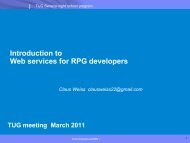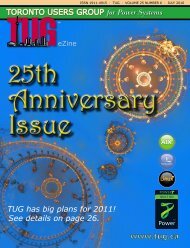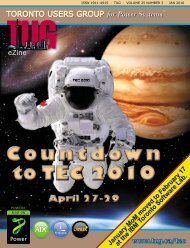admin@tug.ca
Meeting of Members – - TUG
Meeting of Members – - TUG
- No tags were found...
Create successful ePaper yourself
Turn your PDF publications into a flip-book with our unique Google optimized e-Paper software.
© The 5th Wave, www.the5thwave.com<br />
EGL is developed in Websphere with<br />
target platforms of:<br />
• MVS CICS or Batch<br />
• Windows<br />
• Linux<br />
• iSeries<br />
• z/OS USS (Java)<br />
and <strong>ca</strong>n be used to write:<br />
• Batch Server programs<br />
• Interactive 5250 appli<strong>ca</strong>tions<br />
• Web appli<strong>ca</strong>tions<br />
These <strong>ca</strong>n be either Program Driven<br />
or Event Driven Models. Since EGL is<br />
written within Websphere Studio all the<br />
normal tools apply such as:<br />
• Perspectives<br />
• Projects<br />
• Wizards<br />
• Source Editor<br />
• Debugger<br />
• Help<br />
For a more detailed explanation of JSF<br />
& EGL check the TUG Conference CD<br />
for the full session handout.<br />
Intermission<br />
This was our first time at the Meridian so<br />
we didn’t know what to expect in the way<br />
of food. We were not disappointed however.<br />
Everyone was pleased with the excellent<br />
buffet. Then after the usual TUG business,<br />
announcements and door prize giveaways,<br />
we <strong>ca</strong>rried on with our second speaker.<br />
IBM’s Investment in RPG<br />
The 7 o’clock speaker, George Farr,<br />
took us on a tour of RPG – its past<br />
(before V5), present (V5 R1-3), and<br />
future… The future? Does RPG have a<br />
future? George says YES – definitely!<br />
He said that many people get the wrong<br />
impression from the Websphere Development<br />
Roadmap – that IBM is trying to<br />
push everyone into Java – but this is not<br />
the <strong>ca</strong>se. Many programmers will make<br />
the journey to Java, but many more will<br />
stay with RPG (which is a different track<br />
on the same roadmap) and IBM is committed<br />
to supporting those who do.<br />
RPG was born in 1965 on the mainframe<br />
and be<strong>ca</strong>me RPGII in 1971 when<br />
it was adopted by IBM’s first mini-computer,<br />
the System/3. RPGII moved to<br />
the System/34 in 1977 and later to the<br />
System/36. Then in 1980 RPGIII was<br />
created for the System/38, and 1988<br />
AS/400 was launched with RPG/400.<br />
RPGIV and VARPG <strong>ca</strong>me along in 1994.<br />
The modern RPGIV language really hit its<br />
stride in V5R1 on the iSeries platform, and saw<br />
signifi<strong>ca</strong>nt enhancements in V5R2 and V5R3.<br />
Some examples of what’s new in V5R3 are:<br />
• RPG preprocessing for SQL<br />
Preprocessor<br />
• 63 Digit support (Packed and Zoned)<br />
• Second parameter on %TRIMx - char<br />
to trim<br />
• Allow dynamic resizing of arrays,<br />
%SUBARR<br />
• Option to pass trimmed string as<br />
parameter.<br />
• Conversion of date/time/tstamp to<br />
numeric using %DEC.<br />
• Relax rules for result data structure<br />
• New environment variable for Java<br />
method <strong>ca</strong>lls<br />
8 TORONTO USERS GROUP for Midrange Systems – May 2005





